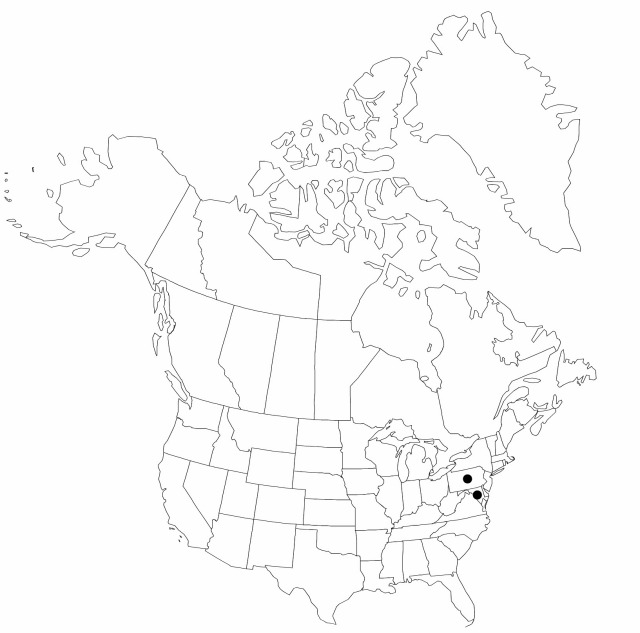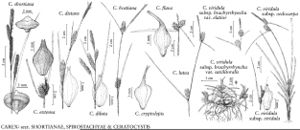Difference between revisions of "Carex distans"
Syst. Nat. ed. 10, 2: 1263. 1759.
FNA>Volume Importer |
imported>Volume Importer |
||
| (5 intermediate revisions by 2 users not shown) | |||
| Line 6: | Line 6: | ||
|place=10, 2: 1263. 1759 | |place=10, 2: 1263. 1759 | ||
|year=1759 | |year=1759 | ||
| + | }} | ||
| + | |special_status={{Treatment/ID/Special_status | ||
| + | |code=I | ||
| + | |label=Introduced | ||
| + | }}{{Treatment/ID/Special_status | ||
| + | |code=F | ||
| + | |label=Illustrated | ||
}} | }} | ||
|basionyms= | |basionyms= | ||
| Line 23: | Line 30: | ||
|elevation=0–50 m | |elevation=0–50 m | ||
|distribution=Md.;Pa.;Eurasia. | |distribution=Md.;Pa.;Eurasia. | ||
| + | |introduced=true | ||
|discussion=<p><i>Carex distans</i> is an extremely rare adventive in North America, known only from two stations, an old one from Philadelphia and a 1948 collection from Charles County, Maryland. The latter site should be searched to determine if the species is still a part of the North American flora.</p><!-- | |discussion=<p><i>Carex distans</i> is an extremely rare adventive in North America, known only from two stations, an old one from Philadelphia and a 1948 collection from Charles County, Maryland. The latter site should be searched to determine if the species is still a part of the North American flora.</p><!-- | ||
--><p><i>Carex</i> fuscula d’Urville var. distenda (Kunth) Kükenthal [C. distenda Kunth] has apparently been collected once as a waif more than a century ago near Philadelphia, Pennsylvania. It would key more or less to <i>C. distans</i>, at least with perigynium characters, but differs in having the pistillate spikes aggregated around the base of the staminate spike.</p><!-- | --><p><i>Carex</i> fuscula d’Urville var. distenda (Kunth) Kükenthal [C. distenda Kunth] has apparently been collected once as a waif more than a century ago near Philadelphia, Pennsylvania. It would key more or less to <i>C. distans</i>, at least with perigynium characters, but differs in having the pistillate spikes aggregated around the base of the staminate spike.</p><!-- | ||
| Line 34: | Line 42: | ||
-->{{#Taxon: | -->{{#Taxon: | ||
name=Carex distans | name=Carex distans | ||
| − | |||
|authority=Linnaeus | |authority=Linnaeus | ||
|rank=species | |rank=species | ||
| Line 49: | Line 56: | ||
|publication title=Syst. Nat. ed. | |publication title=Syst. Nat. ed. | ||
|publication year=1759 | |publication year=1759 | ||
| − | |special status= | + | |special status=Introduced;Illustrated |
| − | |source xml=https:// | + | |source xml=https://bitbucket.org/aafc-mbb/fna-data-curation/src/2e0870ddd59836b60bcf96646a41e87ea5a5943a/coarse_grained_fna_xml/V23/V23_976.xml |
|genus=Carex | |genus=Carex | ||
|section=Carex sect. Spirostachyae | |section=Carex sect. Spirostachyae | ||
Latest revision as of 20:44, 5 November 2020
Culms 40–80 cm. Leaves: basal sheaths brown to orange-brown; blades of flowering stems mostly basal, gray-green, flat, shorter than stems, widest blades 3–4.6 mm wide, margins scabrous. Inflorescences: longer peduncle of terminal spike 2–5(–8.5) cm; proximal bract shorter than inflorescence; pistillate spikes 2–4, ascending, widely separated from staminate spike, pedunculate, ovoid to short-cylindric; terminal staminate spike (15–)20–32(–40) × 2–2.5 mm. Pistillate scales brown, with green or whitish, 3-veined midrib. Staminate scales brown, ovate-elliptic, margins scarious, apex obtuse or apiculate. Anthers 2.5–3.5 mm. Perigynia grayish green to greenish brown, 3.5–4.6 × 1.1–1.4 mm, apex contracted; beak (0.8–)1–1.4 mm, scabrous. 2n = 68, 70–72, 74.
Phenology: Fruiting late Jun–Jul.
Habitat: Damp meadows, ballast near coasts
Elevation: 0–50 m
Distribution

Introduced; Md., Pa., Eurasia.
Discussion
Carex distans is an extremely rare adventive in North America, known only from two stations, an old one from Philadelphia and a 1948 collection from Charles County, Maryland. The latter site should be searched to determine if the species is still a part of the North American flora.
Carex fuscula d’Urville var. distenda (Kunth) Kükenthal [C. distenda Kunth] has apparently been collected once as a waif more than a century ago near Philadelphia, Pennsylvania. It would key more or less to C. distans, at least with perigynium characters, but differs in having the pistillate spikes aggregated around the base of the staminate spike.
In Europe, Carex distans has 36 or 37 pairs of chromosomes (A. O. Chater 1980; E. W. Davies 1955; M. Luceno et al. 1987; A. Strid and R. Franzen 1981).
Selected References
None.
